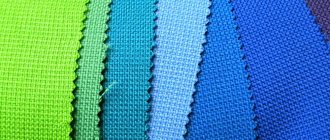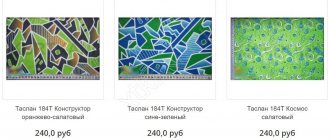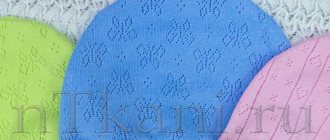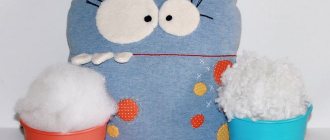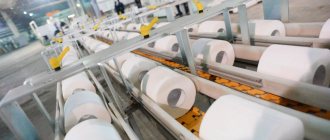Every day, many of us wear clothes made of fabric that is pleasant to the body, the outside of which is smooth and dense, and the inside is soft and brushed. This is footer fabric. Due to its qualities and low price, this fabric is very popular among manufacturers and lovers of comfortable clothing for home, sports and children. In this article we will talk about what kind of fabric footer is, its types and positive properties.
What is a footer and its types
The main composition of footer fabric is cotton threads. The fabric is not woven, but rather knitted, making the material very dense and wear-resistant. For greater elasticity and strength, lycra, wool and polyester are added to cotton fibers when knitting fabrics. By adding Lycra the footer becomes knitted.
A brushed footer is made by weaving two threads: smooth, strong and soft, loose. Because of this, the front and back sides of the fabric are different from each other.
The quality of the fabric also depends on the length of the main thread. Knitted material made from short threads is more vulnerable to damage and wears out faster, such fabric is called “Open End”. The medium-length ones are “carde”, and the long ones are “pene”. If the label of the fabric says “footer foam”, this means that this is a material of the highest quality.
Footer fabric has three varieties:
Single thread - thin material knitted into one thread. It has a smooth front side and a soft back. It is used when sewing clothes for children: pajamas, home suits, clothes for newborns.
Double-thread footer is a denser fabric consisting of two threads. The front side is smooth with a small ribbed braid, the back side is brushed. This type of footer is used to make tracksuits, insulated sweatshirts, and sweatshirts.
Three-thread footer is a very dense material. Its internal fleece is longer and thicker than that of a two-strand footer. This fabric is mainly used for making seasonal outerwear, and therefore wool and polyester threads are added to it to increase density and wear resistance.
Single thread footer
Double thread footer
Three-thread fleece footer
The density of the footer is different and depends on the number of threads. Basically, its density is adjustable from 170 to 350 g/m2.
FOOTER features and material properties
FOOTER
Probably each of us has a couple of footer items in our wardrobe. Hoodies, sweatshirts, sweatpants and even dresses. Clothing made from this fabric not only does not lose its relevance, but also becomes more and more popular every year. This popularity is associated primarily with the high comfort of products made from footer. Let's look at the features and properties of this material.
PECULIARITIES
Footer is a natural cotton-based material. A small amount of synthetic threads can be added to its composition to increase strength and elasticity. High-quality fabric must contain at least 80% cotton.
Production takes place in 2 stages. First, the main fabric is woven from smooth fibers, and then loose and loosely twisted threads are used to create a pile by loop pulling. As a result, the material turns out to be two-sided, the back side is fleecy and soft, and the front part is dense and smooth.
In addition to the composition, the types of this loop material are divided according to the manufacturing method: “ring”, “singing” and “openend”. They differ in terms of wear resistance; the last variety is considered the most short-lived. To sew my products, I use peñe footer; this is cotton jersey of the best quality. It is woven from the longest fibers of cotton. Threads based on such cotton are extremely durable, uniform in structure, free of lint and fluff. Threads of “penye” quality also undergo special processing that eliminates defects, so that things made from penye do not peel off in the future and do not become deformed when washed and worn.
TYPES OF MATERIAL
2-thread footer - this material may include lycra and polyester. Such additives increase the strength and elasticity of the fabric, and also increase the service life of clothing. Despite the fact that the 2-thread footer is quite thin, things made from it are warm. 2 thread is well suited for sewing children's clothes.
3-thread footer - when producing this type of material, synthetic threads and wool fibers can be added to the composition, which makes the fabric even warmer. The wrong side of the fabric has larger loops than 2-thread footer and greater density. The material is less stretchable and is well suited for sewing sports and casual wear.
Footer with fleece - using a special technology, the “loops” on the reverse side can be fluffed, this is how you get footer with fleece - the warmest and softest of all types of fabric. This fabric is used to make children's, sports, casual and outerwear.
ADVANTAGES
1. Air permeability - the structure of the fibers and the method of weaving allow air to circulate freely,
2. Hygroscopicity - the footer absorbs water well. This means that during active movement all moisture from the skin will be comfortably absorbed by the fabric,
3. Hypoallergenic - due to its natural origin, the material does not irritate the skin and does not cause itching,
4. Wear resistance - with proper care, clothing made from footer will last for many years. The fabric is durable, does not fray, holds color and shape well,
5. Heat retention - good air exchange and hygroscopicity allow you to effectively retain heat between the fabric and the body,
6. Hygiene,
7. Dimensional stability,
8. Eco-friendly.
FLAWS
The footer has very few disadvantages:
1. The material does not tolerate high temperatures and may become deformed. This means that it cannot be washed in hot water and dried near an open fire or on a hot radiator,
2. Ultraviolet rays can also damage fabric, so don't leave things on a sunny windowsill or balcony.
CARE OF FOOTER PRODUCTS
All the few imperfections in the fabric can be smoothed out with proper care:
1. The water temperature should not exceed 30-40 degrees.
2. Before putting things into the drum of the washing machine, you need to turn it right side out and fasten the zippers and buttons. This will help protect the pile from damage,
3. When washing colored footer, it is better to use appropriate powders and liquids,
4. Do not boil - this leads to destruction of the fibers and deformation of the product,
5. Do not wring with force or twist when washing by hand, and in automatic mode, the drying function should be turned off,
6. Products made from lining should be dried naturally, away from heating devices and direct sunlight.
7. Iron the footer from the inside out; the iron’s heating mode should be set to the minimum setting; it’s better not to iron items made from fleeced footer at all, or from the face to the minimum setting.
Footer is one of my favorite materials, I approach the creation of each model very carefully, looking for new shapes, details, colors, testing patterns several times to achieve the best fit. I hope you enjoy my works. Thank you for your attention!
Pros and cons of footer
In addition to the fact that the footer material is very soft and pleasant to the body, it also has a number of advantages.
- Naturalness. This means it allows air to pass through well and does not create a greenhouse effect under clothes. A slight addition of lycra to the fabric does not affect this property in any way.
- Strength and elasticity. Thanks to loop knitting, items do not stretch out and return to their original appearance after washing.
- Availability. Clothes made from footer and the material itself are inexpensive, which is surprising given the excellent quality.
- Heat retention. The soft fleece on the reverse side is not only pleasant to the body, but also perfectly retains heat, while preventing the body from overheating.
- Elasticity. Their knitted footer garments softly hug the body and conform to its shape.
- Easy to care for. In order for things to maintain their original appearance, it is enough to properly care for them, and there are no special tricks in this.
- Nice appearance. Brushed fabric looks very nice and can be used to sew not only tracksuits, but also beautiful jackets and short coats.
- Ease of processing. Seamstresses note that it is very easy to sew from footer even for novice craftswomen. It does not crumble at the cut site, does not slip, and does not curl at the edges.
One of the disadvantages is that with intensive washing at high temperatures, the color of the fabric may fade, just like under bright sunlight.
Detergents
Light-colored footer products can be effectively washed by hand using laundry soap. For machine washing, some housewives successfully use non-aggressive washing powder.
ARTICLE FOR YOU
How to properly wash linen and polysatin items
But the best results without damaging the tissue can be achieved using gel-like compositions. It is advisable to give preference to universal brands that have a gentle effect on different types of fibers:
- The biodegradable hypoallergenic Synergetic gel has a good cleaning effect, preserving the shades and texture of the fabric.
- Sion gel is easy to wash, does not deform fibers, and removes dirt with low heating of water.
- Aqualine gel ensures cleanliness and freshness of washed items without color distortion.
- Allows you to effectively machine and hand wash different types of products made from HAAX gel footer.
- Concentrated Chirton gel copes with stains when washing in warm water.
- Corat Universal gel is used for delicate types of textiles, preserving the richness of the shades.
Washing gel
The advantage of gel detergent compositions is their easy dissolution in water, which does not require much heating. They remove even complex stains. When rinsing, no soap particles remain in the fibers.
What is sewn from footer
If you are a beginner or an experienced seamstress, then you have probably already sewn something from this fabric. And if you’re still wondering, we’ll tell you what to sew from footer.
- A tracksuit made of fleece fleece will become an indispensable friend on an autumn run or walk.
- Warm diapers, rompers or overalls will come in handy for the baby. By the way, from 3-thread footer you can sew an excellent insulated jumpsuit for the fall.
- Dressing gowns, sweaters and trousers - all this and much more can and should be sewn from footer and then you will feel as comfortable as possible.
- Warm outerwear - jackets, coats, sweatshirts.
Drying
It is recommended to dry footer products in the shade. This will avoid the damaging effects of ultraviolet rays.
ARTICLE FOR YOU
How and with what to wash spandex clothes and underwear
You can hang fairly quick-drying items indoors, providing ventilation. You should not try to speed up drying by placing them on heating radiators, as excessive heat damages the fibers.
Drying clothes
Outerwear, sweaters, sweatshirts are wrung out of excess moisture, wrapped in a terry towel. To maintain their shape, such products are laid out, carefully leveled, on the table, placing a thick blanket or towel.
How to wash, dry and iron footer items
There are no special tricks in caring for things made from footer, however, by following our tips you can ensure that your things look attractive.
- It is better to wash clothes made from this material at a temperature no higher than 40 degrees. Otherwise, the item may shrink in size, pellets may appear, and the color may change.
- Before washing, it is better to fasten all zippers, Velcro and other accessories on clothes so that puffs do not form on the product.
- You can squeeze it in a machine.
- Dry flat on the balcony or in the house on a clothes dryer.
- You can wash it with both powder and liquid gel.
- For better rinsing of fiber products, turn on the additional rinse mode.
- You can iron both the front and back sides with a not very hot iron.
As you already understand, footer is a very practical fabric. Things made from it are stylish and comfortable to wear. So feel free to buy materials and create! Good luck!
Variety of classifications
Footer has many varieties. The classifications are based on various criteria. Typically, fabric is divided according to composition, density, and quality of raw materials.
Compound
The material is made of cotton. Cotton fibers are necessarily present in the composition. 100% cotton fabric is considered a classic. It is this type, thanks to its hypoallergenic properties, that has found application in sewing clothes for little ones.
But sometimes the composition contains artificial or synthetic additives. If their percentage is small, this has a beneficial effect on the external aesthetics and quality indicators of the lining fabric.
| Additives in the composition | Fabric Features |
| Wool | Wool fibers additionally insulate the footer. Clothing made of this material warms well, providing optimal heat transfer. But problems with tactility may arise. Wool can irritate the skin. Therefore, clothes that do not have direct contact with the body are made from this variety: jackets, sweatshirts, raincoats. Sometimes fabrics with wool fibers are used for lining. |
| Viscose | Aesthetic and comfortable combination. Cotton provides high hygiene. Viscose – attractive appearance and additional strength. But, if the fabric is not decated, it may shrink after washing. Among the advantages of this variety are softness and affordable cost. |
| Polyester | Added to increase wear resistance. The material becomes stronger, more durable, and wrinkles less. But the percentage of the additive should not exceed 20%. Otherwise, hygiene decreases and the footer stops allowing air to pass through. |
| Lycra (or elastane) | Gives strength, elasticity, mysterious shimmer. Dresses and sweaters fit the silhouette. The stretchability increases and the clothes fit more easily on the figure. At the same time, the material is resistant to creasing and does not pill. It does not need to be ironed after washing. The optimal percentage of the additive is no more than 5%. |
By weaving method
Depending on the production technology, there are 3 types:
- single thread footer. Thinness and lightness are the distinctive features of this variety. Density 170-190 g/sq.m. meter. It is usually 100% cotton, so it provides complete tactile comfort. It is used to make clothes for the home and children's clothes;
- two-thread. Soft but durable, it has a stretch effect, that is, it stretches in 2 directions. During manufacturing, 2 weakly twisted threads are additionally added to the ground, forming a covering. The reverse side may have a looped or brushed surface. One of the varieties is the “terry” loop, which resembles terry. And this material itself is called frenchterry (terry knitwear). Products made from two-thread thread are quite voluminous. Tracksuits and demi-season clothing are made from it;
- three-strand. Smooth, durable fabric with a density of at least 300 g/m2. meter. Polyester, lycra and even Lurex (Italian or Turkish) can be used as additives. Additional threads are attached to the reverse side, creating a fluffy bouffant or looped texture. Three-thread items are suitable for winter: you will never freeze in them.
A material with a pronounced looped texture on the reverse side is called a three-thread loop. The soft pile on the reverse side indicates that this is a three-thread fleece. In the production of such fabric, combed machines with special needles are used. Three-thread fleece is the warmest.
By quality
The appearance and performance of the footer largely depend on the quality of the raw materials used, namely the length of the cotton fibers. There are 3 types of fabric on sale:
- Peña. Made from fibers 35-70 mm long. They are uniform in structure, durable, without fluff or lint. During the production process, they undergo additional processing, thanks to which they do not further deform, stretch, or pill. The best type of processing is used in the manufacture of foam compact fabric. This fabric is more durable and does not wrinkle.
- Ring (or card). It is made from looser threads 27-35 mm long. Economical knitwear, which is easily distinguished by the small fluff on the surface and the roughness caused by it. The ring is quite wear-resistant, comfortable to wear, with pleasant tactility.
- Knitwear made of short fibers 20-27 mm long. They have the hygroscopicity, breathability and other advantages of cotton, but are not durable enough. In addition, there is a clearly visible fluff on the surface, which after a few washes can turn into pellets, and the product itself loses its shape. Such threads are treated with enzymes that make the fluff resistant to pilling.
The quality of the finished knitwear also depends on the place where the cotton grows. The most valuable products are made from Egyptian, Turkish, and Uzbek cotton.
Application
All knitted fabrics of the group are universal. The difference is expressed in surface quality, density and thickness. The purpose of the garment depends on these indicators.
Footer foam has found wide application in the production of clothing. For items in the linen group (including the second layer for newborns), a single-thread type of knitwear is used with slight hairiness on the reverse side. Composition: 100% cotton.
It is recommended to sew children's products for nursery and primary school groups from cotton material that does not contain synthetic additives. Two-thread foam footer with lycra is used for sewing sportswear. It has the ability to “breathe”, is wear-resistant, and does not restrict movement.
Three-strand footer made from foam fibers is used in sewing warm clothes for children and adults: sweatshirts, hoodies, suits. Wool-blend fabrics provide maximum thermal protection.
Fabrics vary in thickness and density. Single-thread knitwear is light and thin, suitable for lingerie items, pajamas, and homewear sets. 3-thread polyester footer is a dense, thick material. At the same time, it remains elastic, easy to cut and sew. The edges of the fabric do not fray. With proper care it does not shrink.
Footer production and composition
Cotton jersey remains a pleasant and comfortable fabric to wear. The smooth front side and delicate back mean a special production technology. Weaving factories produce material from two tight threads and a third futher thread, which creates a pile at the bottom. The addition of synthetic fibers to the raw materials for the production of knitwear makes it elastic and wear-resistant.
The main thread (knit) is dense and strongly twisted, it creates the front side of the fabric. The loose structure of the lining thread creates a soft back pile through the formation of small loops.
The three-thread density is 300 g/m2. m. 80% cotton, which is part of the knitted fabric, makes it warm. Adding viscose or polyester improves the dyeing process. Knitwear is produced plain-dyed and printed in gray-white melange type. Products are decorated with thermal printing designs (prints), embroidery and appliqués.
You might be interested in this Composition and description of natural and artificial velvet fabric
Applications
History of the material
There is no information about where such fabric began to be produced for certain. The beginning of the 20th century was marked by wars, and speculation about who the inventor was faded into history. It is possible that the birthplace of knitwear was Egypt or India, because these countries have grown cotton since ancient times. But the lack of appropriate technologies in the homeland of cotton refutes this version.
Knitted fabric
The canvas, despite the lack of a history of creation, has a German origin of the name. The word Futter is translated as “lining fabric”. The correspondence is not enough, but knitwear is used with pleasure for sewing clothes. The time of appearance dates back to the beginning of the 20th century. Not so long ago, knitted clothing became especially popular.
Important! The three-thread footer is made from pure cotton with a small proportion of synthetics. I especially liked the fabric due to its softness and ease of wearing. The pleasant-to-touch fabric is loved by both adults and children. But few people know three-thread fabric - what it is, why it is called that and how it is produced.
Brushed knitwear
Fabric properties
Footer is one of the warmest and most comfortable types of knitwear. With soft brushing on the reverse side, the material is pleasant to the human body. The fabric has already proven itself in the high-quality textile market and is not inferior to many types of fabrics in the following indicators:
- Environmental friendliness . The cotton content makes the material safe for all categories of people. Even a small amount of synthetic additives does not reduce the beneficial properties of the footer. In this it is superior to fleece, which has similar qualities, but is made from synthetic raw materials.
- Hypoallergenic . The fabric does not cause itching or irritation on the skin. The material does not emit any harmful substances.
- Air exchange . With the lined weave and fiber structure, excellent air circulation is achieved, which ensures oxygen flow to the skin. In such clothes it is never stuffy.
- Hygroscopicity . The material has good moisture absorption. Drops of sweat released during active activities will be easily absorbed by the material.
- Ability to retain heat . With good breathability and hygroscopicity, heat is retained between the material and the body.
- Durability . The dense fabric perfectly withstands mechanical deformation.
- Wear resistance . There are no abrasions, pilling or puffs on the fabric. This makes the footer a durable material.
- Form stability . Loop weaving makes the lined fabric resilient and elastic. After stretching, the canvas returns to its previous appearance.
- Easy care . The material does not require complex rules in maintaining the excellent appearance of the products.
- Affordable price . Things made from high-quality material are available to almost any consumer.
Types and scope of application
It is customary to distinguish three main types of this fabric material:
- Single thread. Thin cotton material. Suitable for the production of children's clothing and items for newborns and babies. It cannot cause any harm to a person.
- In two threads. Dense products and felt lint on the inside. Lycra is often used for manufacturing (so that there are no questions about what kind of fabric the footer with lycra is made of). The presence of lycra allows the fabric to stretch while maintaining its shape, making it stronger and more interesting to look at. Suitable for sewing pajamas, dressing gowns, tracksuits, weekend and casual wear.
- Three-thread footer. The fabric is very dense and has a thick and long pile. The products are warm; wool, lycra or polyester are added during production. Used for the production of outerwear intended for wear in the cold season. If you need to clarify what kind of fabric a brushed footer is, then it is a fabric material created using three threads.
Read about what foam footer fabric is and reviews about it on another page.
It can be seen that the scope of application directly depends on the characteristics of the production of fabric material.


